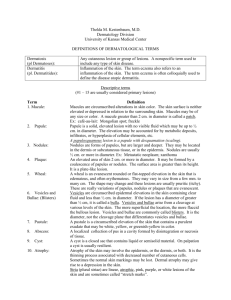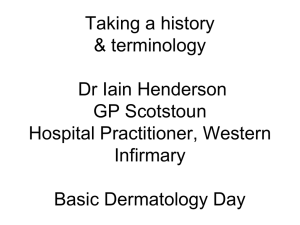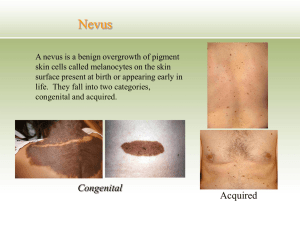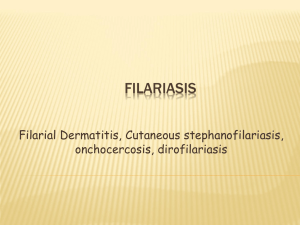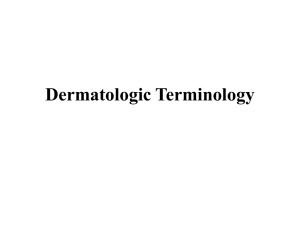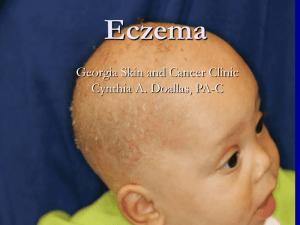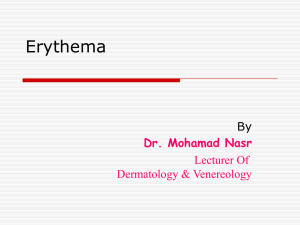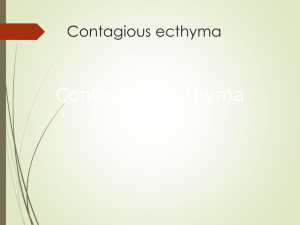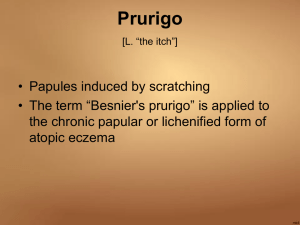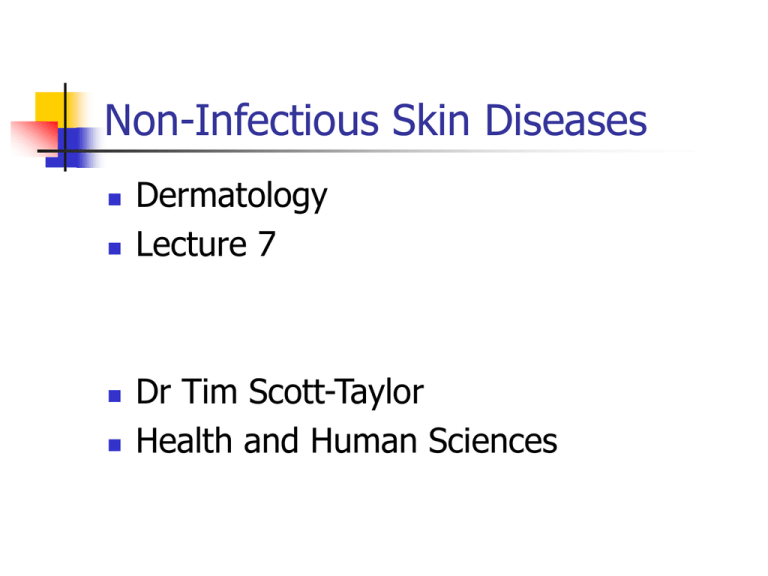
Non-Infectious Skin Diseases
Dermatology
Lecture 7
Dr Tim Scott-Taylor
Health and Human Sciences
Topics
Topics covered;
nomenclature
kinds of lesion
scaling lesions
blistering lesions
dermatitis
Learning Objectives
to be familiar with the description of
different kinds of rashes and spots
to be acquainted with the underlying
mechanism of pathology in dermatoses
to know particular examples of skin
disease
Diagnosis
There is systematic approach involving;
visual interpretation of lesion characteristics
physical examination
history
biopsy
diagnostic tests
A special and specific lexicology of terms for diagnostic
description
History and Examination
Relevant information;
- systemic disease
- use of medications
- similar cases in family
- longterm sun exposure
- occupation
- geographic location
- previous skin diseases
- sexual history
diabetes, hepatitis
toxic epidermal necrolysis
atopy
tumours
contact dermatitis
insect bites, lyme disease
syphilis, gonorrhea
history of particular lesion, movement, size
Description
A particular terminology has developed to define skin lesions
primary:
describes morphology or lesion type
macule, papule, plaque, wheal, cyst, nodule, tumor,
vesicle, bulla and pustule.
secondary: configuration, texture,
scale, crust, lichenification, scar, excoriation, fissure,
ulceration, ulcer, erosion and atrophy.
vascular lesions:
blood sequellae, pathology
purpura, petechiae, ecchymoses, telangiectasia
shape:
annular, serpiginous, flat-topped, domed
Primary Characteristics
Macule: flat and well-demarcated lesion < 10 mm diam.
characterised by color change Eg: ephelid or "freckle"
vitiligo
Papule: elevated, solid and circumscibed lesion, usually 1 cm or less
Eg: hyperkeratotic: warts, seborrheic keratoses
purple: drug eruptions, Kaposi's sarcoma
Plaque: elevated, flat-topped, firm and superficial lesion, usually <1cm
Eg: psoriasis
eczematous dermatitis
Wheal: transient, solid, itchy, raised area of cutaneous edema and
erythema. Irregular shape, variable diameter and blanching.
Eg: urticaria
insect bites
Primary Characteristics
Nodule: raised, circumscribed, firm lesion of variable diameter
Vesicle: elevated, thin-walled lesion; filled with serous fluid, <1 cm
Bulla:
elevated lesion filled with clear fluid, >1 cm
Eg: blister, pemphigus
drug eruptions
Cyst:
elevated, encapsulated lesion with semisolid or liquid fill
Eg: sebaceous cyst
cystic acne
Pustule: elevated lesion filled with purulent fuid. Eg: acne vulgaris
deeper in dermis than papule. Seen or palpated
Eg: erythema nodosum, lipoma
Eg: Herpes simples, Miliaria
Dermatitis herpetiformis
impetigo
Primary Skin Lesions
nodule
cyst
bullae
macule
plaque
wheal
vesicle
pustule
Secondary Skin Lesions
Scale:
plate like excrescence of flaky exfoliation
composed of accumulated stratum corneum
Eg: psoriasis, corns, callus
Crust:
a solid consolidation of dried serum, blood,
Eg: eczema, scab
Lichenification: thickened and rough epidermis with
Excoriation: loss of epidermis caused by a traumatic lesion
Erosion: discontinuity of the skin with loss of epidermis,
accentuation of skin markings.
Eg: atopic dermatitis, scabies
Eg: deep scratch, abrasion
usually follows rupture of vesicle or bulla.
Eg: varicella, herpes
Secondary Skin Lesions
Fissure: a linear split or crack in the epidermis and dermis.
Ulceration: round skin discontinuity, loss of hypodermis
Atrophy: reduction of skin thickening leaving an easily
Scaring: hard plaque of dense fibrotic tissue covered by thin
Vegetating: lushly growing, process, usually elevated
Eg: acute eczema
Eg: syphilitic chancre, yaws
wrinkled and/or shiny surface
Eg: aged skin
epidermis secondary to dermis injury, pink, red or
white; atrophic or hypertrophic (keloid)
Eg: healed wound
Eg: leishmaniasis, melanoma
Secondary Skin Lesions
ulcer
lichenification
fissure
erosion
scale
atrophy
Vascular Lesions
Purpura:
Ecchymoses: purpura greater than 1 cm in diameter.
red-purple non-blanching coloured lesions
extravation of blood into the tissue.
Eg: thrombocytopenia, trauma
Eg: trauma, vasculitis
Petechiae: small nonblanching erythematous macules <0.5 cm
rupture of small blood vessels leading to hemorrhage
Eg: age, thrombocytopaenia
Telangiectasia: permanent dilated superficial blood vessels.
Eg: liver disease, breast cancer
Vascular Lesions
purpura
petechiae
telangiectasia:
Diseases
blistering disease:
scaling diseases
dermatitis
Pemphigus
Bullous Pemphigoid
Erythema Multiformes
Bullous Drug Reactions
Dermatitis Herpetiformis
Phytophoto Dermatitis
Pemphigus
rare autoimmune disease
affecting young adults and
middle aged
immune attack of the
desmosomal adhesion
between epidermal cells
fragile blisters, which rupture
easily leaving red eroded
areas
Rapid, life threatening
60mg prednisolone day
Bullous Pemphigoid
• acute blistering disease of elderly
• large tense blisters, often blood stained
• blisters burst leaving denuded areas prone to 2nd infection
• blisters between the epidermis and the dermis filled with
fibrin and mixed inflammatory infiltrate of neutrophils,
lymphocytes and histiocytes
• C3b and IgG bound to the
basement membrane of skin
• treatment by longterm
high-dose oral steroids
Erythema Multiformes
multiple small round blisters of
red/pink rings in "target" lesions
often occurs on the hands
also palms, arms, feet, dorsum
inflammatory response herpes
simplex, streptococcal throat
• small subdermal blisters
• spontaneous resolution 10-14d
• non steroidal anti-inflammatories
asprin, ibuprofen and antibiotics
Bullous Drug Reactions
STEVENS-JOHNSON SYNDROME
small multiple subdernal blisters with extensive
involvement of the mouth and mucus membranes.
TOXIC EPIDERMAL NECROSIS
very severe blisters with extensive involvement
mortality of about 30-50%
Insect Bites
A variety of insect bite can cause
a blisters; fleas (pets)
bedbugs
scabies,
knats/midges,
bees
wasps
more common in young children
sometimes misdiagnosed
eg as chickenpox.
Dermatitis Herpetiformis
rare itchy condition ofl grouped
blisters on localised symmetrical
sites; elbows, knees, buttocks,
shoulders and scalp
subepidermal blisters with cavity
contains oedema fluid and fibrin
marked inflammatory infiltrate
with lymphocytes, histiocytes
and many neutrophils.
gluten-sensitive enteropathy
similar to coeliac disease but no
malabsorption
often blisters not
seen as so itchy that
scratched out leaving
excoriations
Phytophoto Dermatitis
• Photochemical reaction due to
contact with a plant chemical
and sun exposure
• psoralens f giant hogweed
coumarins ro cow parsley
bergamot m parsnips
dill
react with UV celery
• bizarre streaky patterns of
blisters on sun exposed skin
• PUVA, psoralen + UV
treatment for psoriasis
• spontaneous resolution
leaving long-term
hyperpigmentation
Scaling Diseases
psoriasis
parapsoriasis
pityriasis rosea
lichen planus
dissimilar
disorders
grouped
together by
lesions with
similar primary
characteristics
sharply marginated
scaling papules or
plaques without
wetness, crusts,
fissures and
excorations
Appearance and
distribution of
lesions distinguish
the diseases
Lichen Planus
recurrent, pruritic, inflammatory rash
small polygonal flat violaceous
papules may coalesce in scaly patches
often accompanied by oral lesions
T cell autoimmune reaction to basal
keratinocytes + genetic disposition
triggered by a variety of
drugs;
β blockers
antimalarials
NSAIDS
hepatitis C liver disease
graft versus host disease
symetrically distributed on wrists, legs trunk, penis
Lichen Planus
oral mucosa is involved in ~50% cases
reticulated, lacy, blue-white esp. tongue
chronic exacerbations and remissions
new papules occur after minor skin injury
lesions change over time becoming
hyperpigmented, hyperkeratotic, vesicular
plaques that are violaceous and shiny
Treatment by topical corticosteroids
eg; clobetasol and fluocinonide
Parapsoriasis
• poorly understood group of
plaque forming diseases
• 2 types; a small plaque;
benign,
a large plaque;
CTCL precursor
cutaneous T-cell lymphoma
• treatment by phototherapy
or topical corticosteroids
Pityriasis Rosea
mild inflammatory skin disease
diffuse scaly plaques or papules
unknown cause, virus suspected
mostly women 10-35 yr, peaks in
cooler months
begins with ‘herald patch’on trunk
centripetal eruption 7 -14 days later
prodromal malaise and headache
Rose or fawn coloured, raised edge
collarette (tinea)
Remits in 5 weeks, recurrence rare, sun hastens resolution
Psoriasis
well demarcated, raised, red,
scaly plaques typically elevated,
>10 mm with thick silvery scale
hyperproliferation, inflammation
of dermis and epidermis
common, ~1 to 5% population
bimodal onset 16-22 & 57-60 yrs
unknown cause, ~50% familial
non-mendelian inheritance, associated MHC CW6, B13, B17
environmental trigger; injury, sunburn, HIV, β haem Strep.,
stress, alcohol, drugs; β blockers
chloroquine
Clinical Variants
Plaque psoriasis; large welldemarcated plaques usually on
arms, legs, back or scalp is the
most common form
Gutate psoriasis; lesions
appear as multiple small red
raised scaly patches, usually all
over the trunk. Occurs in young
people following a Strep throat
infection.
Clinical Variants
Pustular psoriasis; widespread areas of
pustules over the trunk and limbs, sudden
onset often accompanied by severe
systemic upset with fever and joint pain
Erythrodermic Psoriasis; widespread red
scaly skin often affecting the whole body.
Skin function can be affected with risk of
hypothermia, dehydration, heart failure.
Treatment of Psoriasis
arthritis develops in 5 to 30% of cases, can be disabling
rarely life-threatening but severely affects self-image
time required to treat extensive skin lesions and maintain
clothing and bedding may adversely affect quality of life
treatments extensive, include emollients, salicylic acid,
coal tar, anthralin, corticosteroids, methotrexate
emollient creams, parafin, petrolatum, hydrogenated oils
reduce scaling, best applied after bathing
Salicyclic acid is a keratinolytic, softens scales.
Coal tar and corticisteroids are anti-inflammatory and
reduce proliferation. Used in combination with UV light
(Goekerman regimen)
Dermatitis
superficial inflammation of the skin
characterized by
pruritis
redness
oedema
oozing
crusting
scaling
(vesicles)
Eczema used interchangeably with dermatitis
Atopic Dermatitis
Acute form of immunemediated skin inflammation
familial, major genetic link to
maternal atopy (asthma)
pruritus major symptom;
ranging from mild erythema
to severe lichenification
2 forms: IgE mediated,
extrinsic, 70-80% cases
non-IgE mediated
intrinsic, non-familial
appears in infancy, ~ 3 mo, acute phase lasting 1-2 mo,
red, weeping, crusted lesions often on the face
spreads to the neck, scalp, extremities, abdomen.
Atopic Dermatitis
• chronic phase, scratching rubbing
causes skin to lichenify
• may become generalised, often
present in flexural creases
• associated food intolerance,
wool, sensitivity to sweating
• often improves by age 5; early
asthma,
prolonged
history
• treatment by emollients, creams
moisturising, anti-histamines,
corticosteroids
Contact Dermatitis
eczematous rash site of contact
any site affected, hands and face
two types of reaction: irritant contact
allergic
irritant contact; stratum corneum
repeated exposure
red cracked skin
eg nappy rash
allergic; type IV cell-mediated hypersensitivity reaction
following sensitisation
eg; cosmetics, nickel,
Adult Dermatitis
•
•
•
•
•
•
Eczema on the arm
Becoming more common
Itchy, inflammatory dermatoses where the lesions
are red, lichenified, excoriated, flaky or cracked.
lesions lack well demarcated borders as they fade
into the surrounding skin.
Secondary infection with Staphylococcus aureus is
common causing the eczema plaques to develop
yellowish crusting or weepy areas.
Most common is flexural sites such as antecubital
and popliteal fossae, wrists, ankles , neck and face
but the trunk and any skin surface can be affected.
Allergic Contact
Airborne substances; Ragweed pollen, insecticide spray
Chemicals; tanning agents, formaldehyde in press finishes
Cosmetics; depilatories, nail polish, deodorant
Dyes;
p-Phenylenediamine in hair and textile dyes
Fragrances, acrylic monomers, epoxy, formaldehyde
Antibiotics; bacitracin, neomycin, penicillin, sulfonamides
Antihistamines;
diphenhydramine, promethazine
Antiseptics; thimerosal, hexachlorophene
Latex;
gloves, condoms, catheters, balloons
Metals;
nickel, cobalt, chromates, mercury
Plants;
poison ivy, oak, sumac, ragweed, primrose
Asteatotic Eczema
• occurs s of limbs of elderly people
especially the shins
• skin is red and roughened with a
characteristic "crazed" and fissured
appearance.
Nummular Dermatitis
Discoid dermatitis
inflammation characterized by
coin- or disc-shaped lesions
middle-aged patients with dry
skin, especially in winter
prominent on arms, buttocks
but also trunk
reccurs on previous sites
• no universally useful treatment.
UV A radiation with oral
psoralen (PUVA) and oral corticosteroids are given
Seborrheic Dermatitis
• inflammatory scaling disease
• principally in scalp, face
• Pityrosporum ovale, yeast
commensal implicated
• application of zinc pyrithione,
selenium sulfide, sulfur and
salicylic acid, or tar shampoo
Exfoliative Dermatitis
Erythroderma: widespread
erythema and scaling skin
occurs with prior skin
diseases eg, atopic
dermatitis, psoriasis
dilation of cutaneous blood
vessels, pruritus, diffuse
erythema, epidermal slough
due to drug reaction; penicillin, sulfonamides, barbiturates
or malignancy; mycosis fungoides, leukemia,
diffuse erythema starts in patches but spreads all body.
Affects thermoregulation, nutritional status.
Summary
Many types of skin lesion,
Many with unknown cause
Many with element of autoimmunity
Diagnosis requires thorough knowledge
of symptoms, history and terminology

